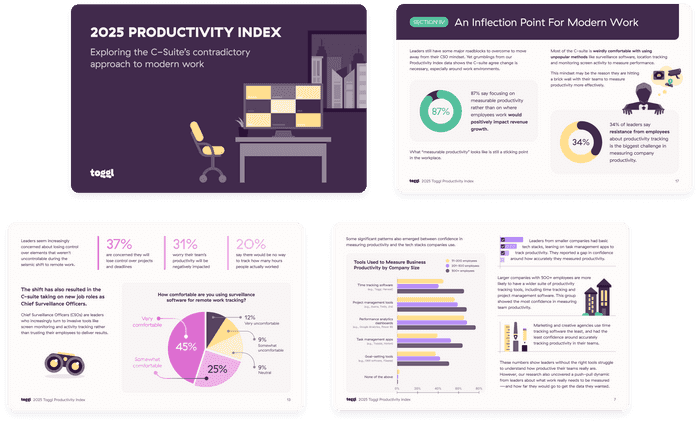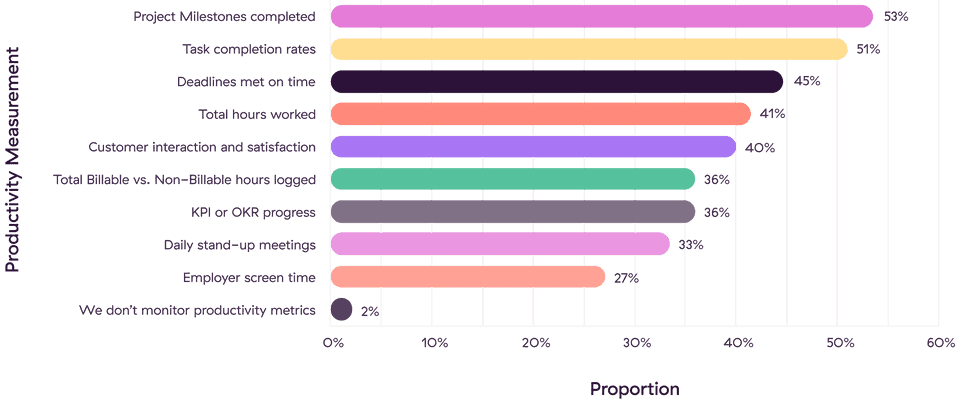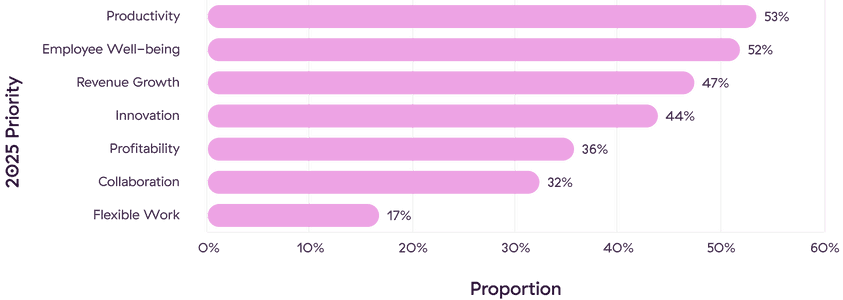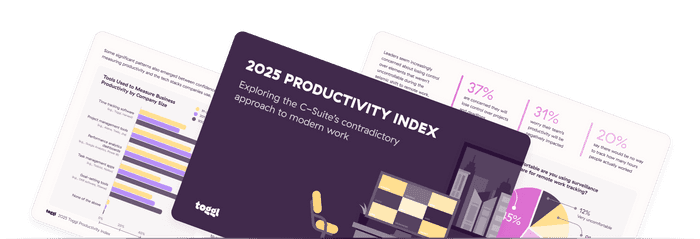Toggl 2025 Productivity Index
Employees want more flexibility in their jobs. The C-suite is doubling down on the traditional workplace.
If 2024 had a slogan, it would be the year leaders played tug-of-war with our work environments.
It was the year many employees (and some companies) embraced remote work and more flexibility. But we also saw many more companies lean into the traditional work playbook — choosing to return to the comfort of the 9-5 with return to office policies.
Amongst it all, a newer, slightly darker trend emerged — leaders got comfortable with employee surveillance software. While the C-suite is aching for more insights into employee productivity, they are going about it the wrong way. 👇

Leaders are prioritizing productivity above all else in 2025, and most of them are confident in their productivity metrics. How they gather these insights is a little… darker.

A majority of leaders are comfortable with using surveillance software. They believe they should be able to access their team’s personal data and even record employee screens to monitor productivity.

Employee expectations around productivity and flexible work have changed, but the C-suite playbook hasn’t. Most leaders still want folks where they can see them — either in-house, working hybrid, or with employee monitoring software.

The top obstacles aren’t a surprise — leaders still believe employees don’t work as effectively without oversight and they struggle to define productivity across certain roles.
While the C-suite’s approach to productivity risks getting stuck in the past, there is light at the end of the tunnel. Most respondents also recognize that focusing on measurable productivity rather than on where employees work would positively impact revenue growth. Let’s take a look at the best findings from surveying leaders in the C-suite.
How employee monitoring could hurt retention and revenue in 2025
Read more in The Index*No personal details required — we’re just giving you the data

Leaders are confident in measuring productivity – but the cracks are showing
cracks are showing
If you take the C-suite at their word, they have the productivity power dynamics of their teams all wrapped up.
An impressive 86% of leaders said that they were confident in their ability to measure team productivity, while only 2% admitted they weren't tracking productivity at all. The majority of respondents were comfortable using project milestones, task completion, and deadlines to measure productivity, while 41% said the hours their team clocked was the metric they relied on.
ProductivityHow do you currently measure your company's productivity?

The majority of respondents also said improving productivity was their top priority for 2025 — beating out innovation, collaboration and profitability as well as eclipsing the focus on flexible work.
Company Priority 2025

Once we scratched below the surface, we started to uncover some of the gaps in their struggle to understand what their teams were working on. 👇
39%
Say there is too much focus on hours worked rather than output achieved36%
Have difficulty defining what productivity looks like in different roles28%
Have limited visibility into remote or hybrid employee activityThere’s also a noticeable gap in productivity and capacity reporting. 57% of leaders admit they could be operating below capacity as they lack the tools to measure underperformance or overstaffing.
The C-Suite's contradiction problem
Our report set out to see if there was a gap between what the C-suite says they value — productivity, performance, collaboration, and revenue — and what they actually prioritize, like rigid work hours and controlling the place of work.
Our suspicions were confirmed. As employees battle for more flexibility in work environments and work hours, company leaders have retreated into processes they know — the traditional workday.
68% of leaders say a 9-5 structure — regardless of whether it’s in-house, hybrid or remote — is essential to hitting productivity and revenue goals.
The answers show a huge contradiction between what structures leaders implement, and what they know will improve engagement and retention.
67%
When we asked leaders if employees should be given more autonomyin the workplace as long as they are delivering results, 67% agreed.
68%
68% of leaders agree employees who have a say in their work environments are more likely to produce high-quality work and meet performance targets.
The further we dug into the data, the more we realised the C-suite’s current actions speak louder than words.
Monitoring employees is turning the C-suite into Chief Surveillance Officers👮🚨🚓
The demand for remote work mixed with the rise of bossware was always going to be a recipe for disaster.
Many leaders believe they should be able to measure employees beyond just task completion and hours worked. Our survey results clearly show companies want control — 70% of leaders admit they are comfortable using surveillance software in a remote work setting.
This has led to the rise of what we’re calling the Chief Surveillance Officer — those turning to invasive tools like screen monitoring and activity tracking rather than trusting their employees to deliver results.
67%
Agree they should have access to employees’ personal data (like location tracking and screen activity) to ensure productivity in any work environment.76%
Agree they should have access to detailed data like activity tracking and screen monitoring at any time to ensure employees are working efficiently.75%
Agree if they are responsible for company performance, they should have the right to track every employee’s activity to ensure they are delivering results.The irony is most of these Chief Surveillance Officers agree that this isn’t the best approach in the workplace — 75% acknowledge that excessive monitoring hurts retention and morale within their team.
This over-reliance on control doesn’t just harm culture, it can impact performance. When employees feel watched, creativity and collaboration suffer, and companies miss the opportunity to make their team feel trusted. Liviu Tanase, founder and CEO of ZeroBounce, says installing software like keyboard monitoring on employee laptops to track every little thing they do is overstepping.

“Leaders know that personal things may happen on company computers. But if you monitor your team’s computers just to catch an “aha, I got you” moment, you really need to question your staff and your company's overall culture. We’re all being monitored in some form already. What matters most is the intent. If you’re doing it to ensure compliance or protect sensitive information, that’s one thing. But if you use it to control your employees, it will erode trust and hurt productivity and retention. CEOs need to ask themselves if they are encouraging a culture of trust and autonomy or one of suspicion.”
— Liviu Tanase, Founder and CEO of ZeroBounce
Some C-suite leaders are sounding the alarm against employee monitoring software
Read more in The Index*No personal details required — we’re just giving you the data
The inflection point for modern work and productivity
There is a sliver of hope on the horizon. While most respondents are comfortable using employee monitoring software, they admit it’s hurting retention and profitability.
65% of leaders admit these rigid policies are driving disengagement in their workforce.
We believe there are other ways to address the root causes of productivity challenges rather than doubling down on surveillance tools and control. And the majority of leaders seem to agree the focus on where people are working is a distraction from productivity.
87% of leaders agree that focusing on measurable outcomes like completed projects and milestones rather than where an employee works would improve revenue.
This shift in focus (and stepping away from invasive surveillance) would help solve another huge issue for leaders — 34% of leaders cite resistance from employees about invasive tracking as a major obstacle for measuring productivity.
Employees don’t want their every move monitored, and they’re not shy about pushing back. Leaders can overcome this by gathering data they need to feel comfortable about their team’s productivity without resorting to invasive tracking tactics like surveillance software.
The numbers don’t lie: empowering employees is good for morale — and your company’s bottom line.
80% of C-suite leaders believe shifting their approach to productivity could increase revenue by up to 20%.
So, what does this all really mean for companies this year?

Read how the C-suite’s comfort in employee monitoring could hurt retention and revenue in 2025
Get the Index*No personal details required — we’re just giving you the data
Methodology
This research was conducted online in the US and UK by Cint on behalf of Toggl, between November 27th and December 3rd 2024. Participants included 466 global leaders from the C-suite, ranging from CEOs to CTOs, COOs, and CFOs in companies with at least 50 employees. All participants identified as working in industries including SaaS, Technology, Marketing, Professional Services, Creative Agencies, and PR.